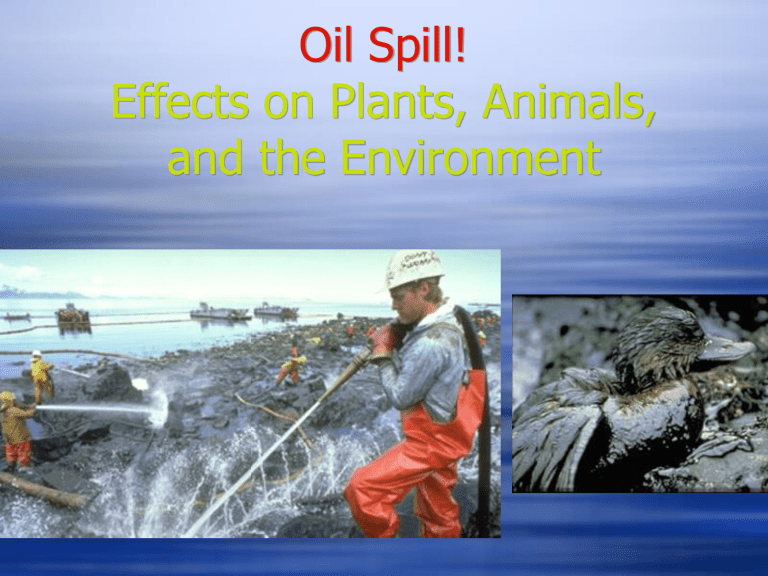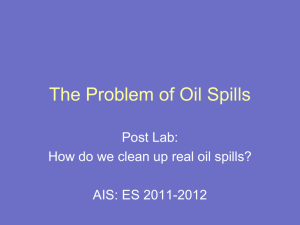oil spill effects
advertisement

Oil Spill! Effects on Plants, Animals, and the Environment • Oil spills are a very dangerous occurrence for the marine ecosystem. • It becomes important to employ various oil spill cleanup methods. • Oil is one of the most abundant pollutants in the oceans. About 3 million metric tons of oil contaminates the oceans annually. • Oil spills vary in their severity and the extent of damage they cause. This can be attributed to variations in the oil type, the location of the spill, and the weather conditions present. • The spread and behavior of the oil spilled in the seas is governed by a variety of chemical, physical and biological processes. • The effects of oil spills experienced not only in the area of the spill, but can also expand over vast regions to negatively impact shorelines and terrestrial wildlife thousands of miles away from the site of the spill. Timeline Oil Spill History Several Methods for cleaning up oil spills Oil Booms • Equipment called containment booms acts like a fence to prevent the oil from further spreading or floating away. Booms float on the water surface and have three parts – 1. A freeboard is the part that rises above the water surface, containing the oil and preventing it from splashing over the top 2. A skirt is placed below the surface and keeps the oil from being squeezed under the booms and escaping 3. A kind of cable or chain that connects the parts to strengthen and stabilize the boom. Connected sections of the boom are placed around the area of the oil spill until it is totally surrounded and contained. Additional Information: → This method is Effective only when the oil is in one spot. → It works when the spill is accessible within a few hours of taking place, otherwise, the area of the spill becomes too large to manage → It cannot be successfully employed under rough sea waves, high wind velocities or fluctuating tides Skimmers • once the oil has been confined by using oil booms, skimmers or oil scoops can be deployed onto boats to remove the contaminants from the water surface. • Skimmers are machines specially designed to suck up the oil from the water surface like a vacuum cleaner. They are used to physically separate the oil from the water so that it can be collected and processed for re-use. Additional Information: • Skimmers can be used to effectively recover most of the spilled oil, so it is economically viable. • The presence of debris poses a major problem to this technique, as skimmers can get clogged easily. Sorbents • Sorbents are materials that soak up liquids by either absorption (pulling in through pores) or adsorption (forming a layer on the surface). • Materials commonly used as oil sorbents are hay, peat moss, straw or vermiculite Additional Information: • The oil can be recovered, and this prevents wastage and further pollution. • After the absorption, the sorbent materials must be effectively retrieved. This is a difficult task and may prove to be worse if ignored. • Sorbents after absorption become heavier (3 to 15 times their weight), and as a result, may sink, making them difficult to retrieve and also pose a risk to aquatic life in the sea bottom. • They are most effective in small spills or to manage the leftover traces of a larger spill. Burning • the oil floating on the surface is ignited to burn it off. This burning of oil can effectively remove up to 98% of an oil spill, which is more than most of the other methods. • thickness of the slick on the water surface needs to be at least 3mm. This is because it would be very difficult (and even nearly impossible) to ignite a layer which is not thick enough. Additional Information: • The toxic fumes released from the burning can cause significant damage to the environment as well as marine life. • The procedure works on spills that are relatively fresh before the oil spreads to a larger area and decreases in thickness. Dispersants • Dispersal agents, such as Corexit 9500, are chemicals that are sprayed upon the spill with the help of aircraft and boats, which aid the natural breakdown of oil components. • They allow the oil to chemically bond with water by increasing the surface area of each molecule. This ensures that the slick does not travel over the surface of the water, and is easier to degrade by microbes Additional Information: • It can effectively be used for spills over large areas. • Use of dispersants can create tarballs. This results in the formation of large tar balls floating on the surface of the water, which often find their way to the shores. • The toxicity of dispersants can affect marine organisms, especially the nonmobile ones such as corals and seagrass. Hot Water and High-Pressure Washing • This procedure is mainly used in situations where the oil is inaccessible to methods of mechanical removal. It is used to dislodge the trapped and weathered oil from locations which are generally inaccessible to machinery. • Water heaters are used to heat up water to around 170°C, which is then sprayed by hand with high-pressure wands. The oil is thus flushed to the water surface, which can be collected with skimmers or sorbents. Additional Information: • The released oil must be immediately and adequately recovered to prevent any further contamination. • Organisms falling in the direct spray zone have a high chance of being badly affected by the hot water. Manual Labor • This method requires hand-held tools and manual labor to clean up the contaminants. It involves hands, rakes, shovels etc. to clean the surface oil and oily debris and place them in special containers to be removed from the shoreline. • Sometimes, mechanized equipment may be employed for providing any additional help and reach out to any inaccessible areas. Additional Information: • This method is applicable only for cleaning up the slick in shorelines. • The process is more economically useful, as unskilled workers with minimal training can be employed • this process is also time-consuming. • The use of heavy machinery can inflict damage upon shorelines, so they should be avoided as much as possible. Bioremediation • Bioremediation refers to the use of specific microorganisms to remove any toxic or harmful substances. • There are various classes of bacteria, fungi, archaea and algae that degrade petroleum products by breaking them down into non-toxic molecules (mostly fatty acids and carbon dioxide). • Sometimes, reagents and fertilizers may be added to the area. These phosphorus-based and nitrogen-based fertilizers provide adequate nutrients to the microbes so that they are able to grow and multiply quickly. Additional Information: • It is a long term procedure and may even take years, so quicker solutions like using booms and skimmers or sorbents may be used if any urgent action is required. • Natural Solution Pseudomonas #1 for oil Chemical Stabilization of oil by Elastomizers • experts have been using compounds like Elastol, which is basically poly iso-butylene (PIB) in a white powdered form, to confine oil spills. The compound gelatinizes or solidifies the oil on the water surface. • The gelatin is easy to retrieve, and this makes the process highly efficient. Additional Information: • It is a quick action method, with typical reaction times of 15-40 minutes. • While PIB is non-toxic and commonly found in foodstuffs, the gelatin may pose a risk of entangling or suffocating the aquatic animals. The treatments follow a general rule: (All distances measured from the shoreline) • 200 nautical miles and beyond – No treatment is used, unless the case is very severe. • Between 20 and 200 nautical miles, booms and skimmers may be used. • Between 20 and 10 nautical miles, dispersants are used. • For areas very close to the shoreline, biological agents are used. Bioremediation




